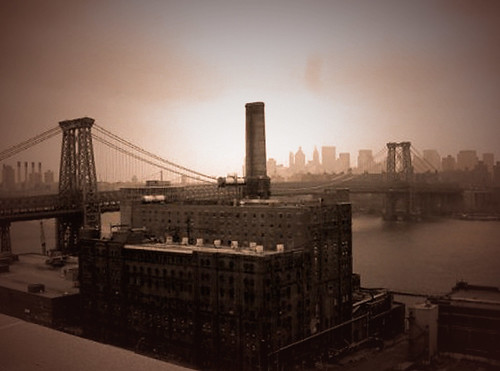
The trip to Williamsburg is conflictive. On one hand, we see brand new shining high-rise steel frame housing; but next to these housing, there might be an old, slipshod low-rised brick building. The conflict is here.
(picture of the Williamsburg Bridge and the Dominos Factory)
The story started with the past of Williamsburg. Williamsburg used to be a factory area with dark streets and crime spots. Along the time, people who lived here would move to upper Queen if they got the fortune. No body wanted to go out after dark.
 At the time of May 11, 2005, the city passed a large-scale rezoning of the North Side and the Greenpoint waterfront. Most of the areas were rezoned to be residential area and it initials the "condo boom" in the Williamsburg.
At the time of May 11, 2005, the city passed a large-scale rezoning of the North Side and the Greenpoint waterfront. Most of the areas were rezoned to be residential area and it initials the "condo boom" in the Williamsburg. Thanks to these large rezoning and the housing projects, people in Williamsburg started to see their neighborhood changing from a scaring place to a nice brand new place to live.
However, when the city decided to trade the large tax breaks with 20% of affordable housing provided by these new residential buildings, the dilemma came to these under-construction projects with the unwillingness of developer to give up their profits to the affordable housing.
The stalled construction sites are just the right expression of these conflicts. It's a representation of the new development and hope and at the same time, the fail of the new development and hope. It's like a sudden hits to the neighborhood when they saw their dream is coming true, is coming along.
The stalled construction site is like a scar on a beauty. It's like an inconvenient truth to both the neighborhood and the larger public. How will this "ugly truth" affect the continuing development of Williamsburg? What can we, as architects, do to this? Where is the breakthrough of this "problem"?
Finally, I wanted to sincerely thank the Engelberts and the Bernard Mass Foundation for providing fund for our trip; David Maundrell who hosted us and shared his thoughts about his neighborhood with us; Paul who showed us his office and gave us insightful suggestions about practicing.




very powerful title image you have now. I look forward to how you will bring together your thoughts and imagery on the sites as interpretations of infrastructure.
ReplyDelete